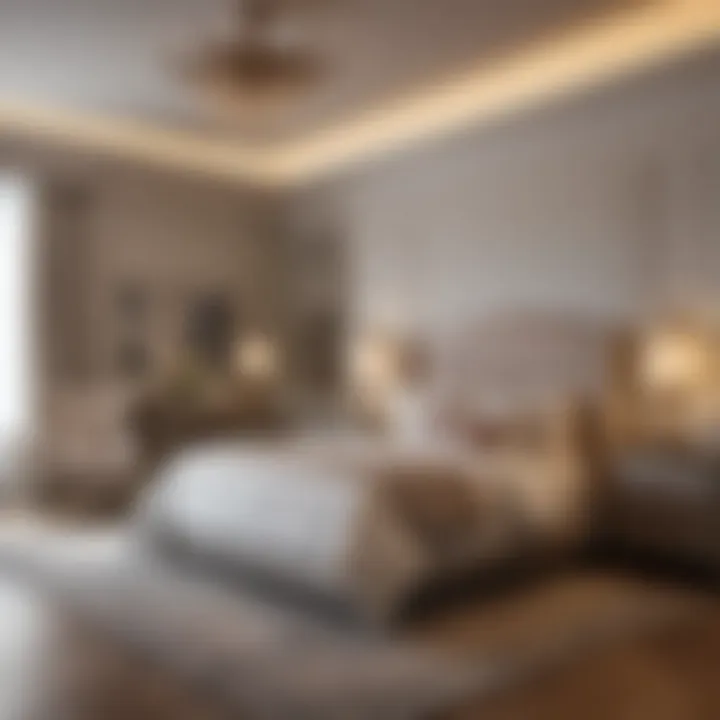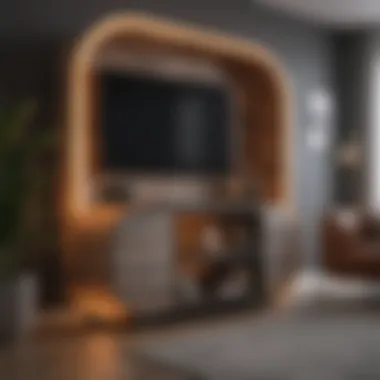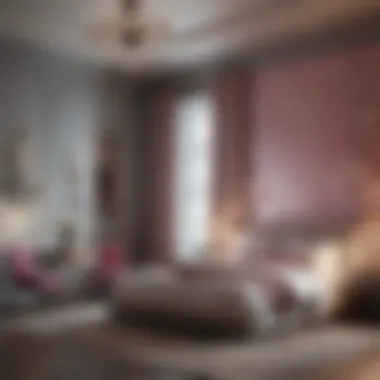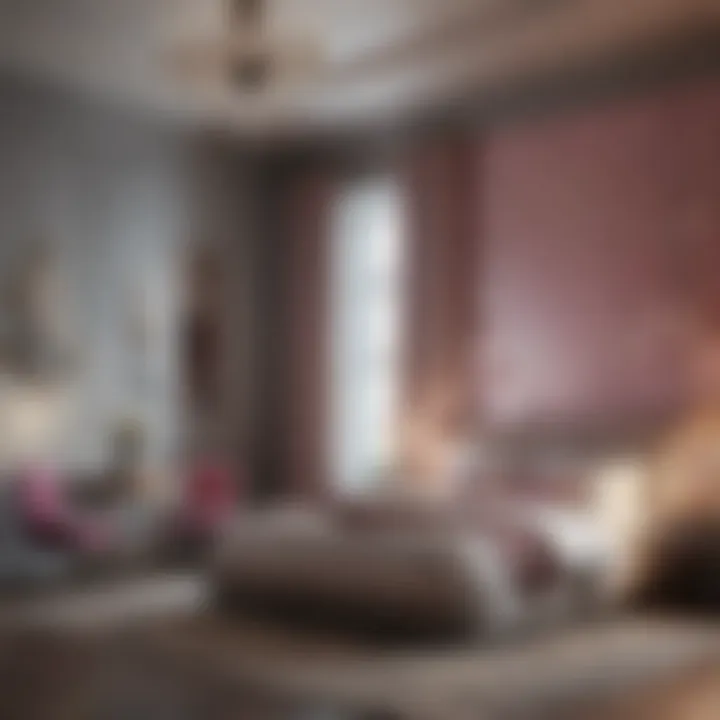Innovative Bedroom Ideas for a Unique Sanctuary


Intro
Creating a sanctuary within your own home is not just a trend but a necessity for many, particularly for those seeking respite from a hectic lifestyle. Bedrooms have become more than mere sleeping quarters; they are now essential spaces for relaxation, work, and personal reflection. This article delves into various inventive strategies to transform your bedroom into a unique retreat, tailored to your personal preferences and lifestyle needs.
A blend of comfort, style, and functionality is essential for achieving an optimal bedroom environment. Furthermore, this exploration will cover contemporary trends, effective color palettes, space optimization techniques, and suggestions for multifunctional furniture. With a holistic approach to bedroom design, the goal is to inspire readers to create a space that not only looks appealing but also enhances well-being.
Current Trends
Color Palettes
Color significantly influences the atmosphere of a bedroom. Light pastel shades like mint green and powder blue are gaining popularity. They bring a sense of calm and clarity into a space. On the other hand, deep, rich colors like navy blue and burgundy add a touch of sophistication and help in creating a cozy environment. Neutrals, too, continue to dominate, especially when paired with bold accents. Understanding which colors evoke emotional responses can guide choices in creating a retreat-like ambiance.
- Pastel shades: Soft and calming
- Rich colors: Sophisticated and cozy
- Neutrals: Versatile and classic
Popular Styles
Different styles cater to various tastes and lifestyles. The modern minimalist aesthetic, characterized by clean lines and clutter-free spaces, is appealing to many. Meanwhile, bohemian styles offer a more eclectic approach, emphasizing textiles and personal decorations. Industrial designs incorporate raw materials and offer an urban feel. Knowing which style resonates with you will shape the overall look and feel of your bedroom sanctuary.
- Minimalist: Clean and uncluttered
- Bohemian: Eclectic and vibrant
- Industrial: Raw and urban
"A well-thought-out bedroom design not only enhances aesthetic appeal but significantly promotes emotional comfort and personal well-being."
Visual Ideas
Gallery of Styled Bedrooms
Incorporating visual references can crystallize ideas for your own bedroom. A gallery of styled bedrooms can provide insights into color applications and furniture arrangements. These images exhibit how different styles can cohesively blend elements while maintaining functionality.
Before-and-After Transformations
Documenting before-and-after transformations can be particularly inspiring. They illustrate the dramatic effects of thoughtful design and organization. The visible change often reflects a more significant emotional shift toward creating a cohesive space.
The transformative power of design is substantial. By embracing innovative ideas and employing effective strategies, anyone can create a bedroom that serves as a unique sanctuary, enhancing overall lifestyle and comfort.
Prelude
Transforming a bedroom into a unique sanctuary is essential for creating a personal retreat in today's fast-paced world. This space serves not only for rest but also as a haven for relaxation and self-expression. Bedroom design can influence one’s mental clarity, emotional well-being, and overall comfort. Achieving a cohesive balance between aesthetics and functionality is crucial when envisioning your ideal retreat.
In this article, we will explore several innovative ideas tailored to enhance the bedroom experience. We will delve into contemporary trends, color palettes that evoke tranquility, and multifunctional furniture aimed at optimizing space without sacrificing style. By examining layout techniques and practical design considerations, we can inform and inspire the reader to develop a space that resonates with their individual tastes.
Considerations such as the arrangement of furniture, choice of textiles, and incorporating personal elements can make a significant difference. A well-thought-out bedroom design promotes relaxation and contributes to better sleep quality. It is integral that the space reflects personal style while addressing practical needs. Thus, diving into this exploration allows house owners to make informed decisions that elevate their living spaces into personalized sanctuaries.
"A bedroom should not just be a place where you sleep; it should reflect who you are and provide comfort and peace."
This journey through innovative bedroom design ideas aims to equip you with insights and strategies to create a harmonious sanctuary that feels both authentic and functional.
Understanding Your Personal Style
Understanding personal style is essential when designing any space, especially the bedroom. This area is where individuals seek comfort, rest, and a sense of identity. A well-thought-out personal style will not only enhance the visual appeal of the bedroom but can also significantly affect the mood and atmosphere.
When exploring personal style, consider the following elements:
- Uniformity of Aesthetic: How would your unique taste reflect in the colors, patterns, and designs?
- Functional Needs: Do you prefer a more minimalistic approach due to a busy lifestyle, or do you appreciate rich textures and numerous elements?
- Emotional Response: Which colors or styles evoke feelings of comfort and tranquility for you?
The benefits of understanding personal style extend beyond mere aesthetics. An individualized approach can create spaces that truly reflect one's personality and preferences, cultivating a serene and inviting atmosphere. The satisfaction of being surrounded by what you love plays an integral role in achieving a peaceful retreat in your bedroom.
Identifying Design Preferences
Identifying design preferences forms the foundation of a personalized bedroom sanctuary. First, assess your existing decor. What aspects do you enjoy? Which elements feel disjointed?
To pinpoint your preferences:
- Compile Inspirations: Look at interior design magazines, websites, or social media platforms like Pinterest and Instagram to gather images that resonate.
- Examine Existing Spaces: Identify common themes and colors in spaces you admire.
- Reflect on Experiences: Consider vacations or hotels where you felt particularly relaxed. What elements contributed to that feeling?
This exercise can lead to clearer visions of desired aesthetics, colors, and themes.
Inspiration from Various Sources
Inspiration can come from seemingly countless sources. Here are several effective avenues:
- Nature: Elements like plants, landscapes, and natural materials can enhance room aesthetics and create harmony in the space.
- Art: Observing artworks or decor pieces that speak to you can evoke design ideas, motifs, and color schemes.
- Travel: Visiting different cultures introduces diverse design philosophies that could inspire unique blends in your bedroom.
Utilizing these inspirations involves selecting elements that resonate most with your identity. Mixing styles thoughtfully can yield surprising and delightful results.
Functional Layouts for Bedroom Designs
When evaluating bedroom designs, the layout is fundamental. A well-thought-out layout establishes both functionality and aesthetics. It dictates how space is perceived and utilized. With the right design, a bedroom can serve multiple purposes, becoming a haven for rest, work, and relaxation. Understanding the dynamics of space ensures comfort, accessibility, and a sense of harmony.
Zoning Techniques for Space Utilization
Zoning techniques are crucial for optimizing bedroom layouts. By dividing the room into distinct areas, you enhance functionality. For instance, separate spaces for sleeping, working, and relaxing can transform a standard bedroom into a multi-use sanctuary. This approach allows for specialized designs that cater to different activities.
Consider the following zoning ideas:
- Designated Sleep Zone: A space that includes the bed and nightstands, promoting relaxation.
- Work Area: Incorporating a small desk and chair can facilitate productivity while fitting seamlessly into the overall design.
- Relaxation Corner: Soft seating, like a chair or chaise lounge, can create a cozy nook for reading or unwinding.
Zoning not only improves organization but also ensures that each area feels intentional. This clarity in purpose reduces clutter and makes the room more inviting.
Incorporating Movement and Flow
Incorporating movement and flow enhances the functionality of a bedroom layout. It's vital to consider how one moves between different zones. A good flow allows for easy navigation without obstruction, which is key in smaller spaces. For instance:
- Pathways: Maintain clear pathways around the bed and access to storage. This design choice prevents feelings of tightness or confinement.
- Furniture Placement: Arranging furniture to promote flow can enhance comfort. Bed placement against a solid wall often fosters a sense of security and stability.
- Visual Connection: Use open designs to promote light and visibility across the room. This can create an illusion of space, making the room feel larger and well-connected.
Clear movement patterns and thoughtfully positioned furniture can significantly enhance the space's overall effectiveness.
Certaintly, investing time in layout planning will yield a bedroom genuinely reflective of personal needs and preferences. It sets the stage for innovative designs and ensures a functional, harmonious sanctuary.
Color Psychology in Bedroom Design


Understanding color psychology is crucial when designing a bedroom. Colors have significant effects on mood and well-being. The right colors can promote relaxation, happiness, and even energy. Bedrooms are personal sanctuaries where rest and tranquility are key. Therefore, selecting a color palette should be a thoughtful process. Harmonious color choices not only enhance aesthetic appeal but also provide feelings of safety and comfort. This section delves into choosing appropriate color palettes and the role lighting plays in color perception, both essential for achieving the desired effect in your bedroom.
Choosing the Right Color Palette
Creating a color palette for your bedroom requires careful consideration. It is advisable to start by identifying colors that resonate with your personality and lifestyle.
- Neutral Tones: Soft whites, beiges, and greys are timeless. They create a calming environment and serve as great backdrops for other accent colors. Neutrals also pair well with various textures and materials, making them versatile choices.
- Cool Colors: Blues and greens evoke a sense of tranquility. They are often associated with nature and can make a bedroom feel serene and expansive. This is ideal for those seeking a peaceful retreat.
- Warm Colors: Yellows and soft oranges add warmth and brightness. These colors can enhance energy levels and promote cheerfulness. They may work well in spaces where some activity or socialization occurs, but should be used cautiously as dominant colors in a bedroom.
When selecting a color palette, it helps to gather samples and visualize how they interact in different lighting conditions. This process enables you to choose a combination that feels cohesive and supportive of your intended mood.
Impact of Lighting on Color Perception
Lighting plays a vital role in how color is perceived in any space, especially in a bedroom. Natural light and artificial light can significantly alter the appearance of colors.
- Natural Light: It typically brings out the true essence of colors. A room that gets a lot of sunlight may amplify the shades of paint you choose. Therefore, consider the time of day and how light shifts in your room throughout the day.
- Artificial Light: Different bulbs can create varying color temperatures. Warm bulbs (around 2700K) offer a cozy atmosphere, while cooler bulbs (5000K and above) may present a more clinical feel. It is wise to test light sources before making final decisions on paint colors.
An effective strategy is to incorporate multiple light sources in the bedroom. This may include overhead fixtures, bedside lamps, and task lighting to create layers and enhance your color choices.
"Colors are more than just pigments; they are tools for creating emotional landscapes within the confines of our personal spaces."
By understanding the psychology of color and the impact of lighting, you can create a bedroom that not only looks appealing but also nurtures your well-being.
Incorporating Multifunctional Furniture
Multifunctional furniture has become a vital aspect of modern bedroom design. With the increasing need for efficiency in our living spaces, furniture that can serve multiple purposes is not just convenient but also essential. It allows homeowners to maximize limited space without compromising on aesthetics or comfort. The benefits of incorporating multifunctional furniture into your bedroom are vast. It promotes organization, enhances usability, and can even contribute to the overall style of the room.
When selecting multifunctional pieces, consider how they can add value to your space. For instance, a bed with built-in storage drawers beneath can help reduce clutter by providing a hidden area to store linens or seasonal clothing. Similarly, a desk that can fold away or transform into a nightstand optimizes functionality without taking up extra room. The key lies in finding items that meet your needs while harmonizing with the existing decor.
Space-Saving Solutions
Space-saving furniture solutions are essential for creating a streamlined and functional bedroom. The aim should be to choose pieces that do not overwhelm the space but, instead, contribute to a more open and airy feel. For instance, wall-mounted shelves can provide vertical storage without occupying floor space. Options like a Murphy bed, which folds up when not in use, turn a small room into a versatile area that can serve various needs.
Additionally, consider ottomans that double as storage units. They provide a place to sit while offering a hidden space for blankets or books. Adjustable furniture, such as extendable tables or sofas that convert into beds, further illustrates how specific solutions can meet diverse needs in a limited area.
Quality and Style in Dual-Purpose Pieces
While functionality is vital, the quality and style of dual-purpose pieces cannot be overlooked. Selecting well-crafted items ensures longevity and a polished look in your bedroom. Investing in quality furniture pays off over time and enhances the overall atmosphere.
Style is equally important. Choose pieces that reflect your personal taste, whether modern, rustic, or eclectic. The intention should always be to create a cohesive look throughout the space. For example, a sleek sofa bed can tie together contemporary elements, while a vintage trunk may add charm and elegance.
By blending quality with style, you not only enhance the functionality of your bedroom but also cultivate an environment that is both inviting and unique. Selecting dual-purpose pieces requires a discerning eye, but the rewards in comfort and design are well worth the effort.
"An efficient use of space leads to a more relaxing and peaceful environment."
Textile Choices for Comfort and Aesthetics
Selecting the appropriate textiles for your bedroom is crucial in creating an environment that exudes both comfort and style. Every element, from your bedding to the curtains, plays a significant role in defining the atmosphere of the space. Textiles are not just functional; they add texture, warmth, and personality to your sanctuary. The choices you make reflect your taste while enhancing relaxation and comfort, which is essential for a bedroom.
When considering textiles, one must take into account fabric types, colors, and patterns. Natural fibers, such as cotton or linen, offer breathability and comfort. Synthetic materials, although often more affordable, can contribute to discomfort due to poor air circulation. It's essential to seek a balance that elevates comfort while maintaining aesthetic appeal.
Several benefits come from making thoughtful textile choices. Well-selected textiles can influence the bedroom's acoustics, warmth, and even air quality. Additionally, they can help with seasonal adaptation. For example, heavier textiles in winter bring warmth, while lighter fabrics in summer ensure a comfortable sleeping environment.
Selecting Bedding that Fits Your Style
Bedding serves as the focal point of any bedroom. It influences how the entire room feels. Your selection should resonate with your personal style and enhance the space's overall theme. Consider the design elements that define your preferences. Whether you favor a minimalist approach, vibrant colors, or intricate patterns, ensure your bedding complements these choices.
Quality, comfort, and maintenance are essential factors when selecting your bedding. Look for materials that not only feel good against the skin but are also easy to clean. Cotton, for instance, is soft and machine washable, making it a practical choice. Additionally, consider the thread count; higher numbers often indicate softer fabric.
When you have chosen your duvet, sheets, and pillowcases, think about layers. Achieving a layered look can enhance both comfort and aesthetics. This approach allows for easy adjustments to suit the changing seasons, making your bed inviting year-round.
Layering Textiles for an Inviting Atmosphere
Layering textiles is key to building an inviting atmosphere in your bedroom. This technique not only adds visual depth but also creates a sense of warmth. Start with a strong base by selecting your main bedding. Once that is established, introduce additional layers through throws, pillows, and blankets. Mix textures and colors to create a harmonious yet dynamic look.
The textures can range from soft knits to smooth silks, ensuring variety in touch and appearance. Also, consider using different shades within the same color palette for added interest without overwhelming the senses.
Keep in mind that layering serves a dual purpose: it enhances comfort and adds style. A chunky knit throw offers warmth, while decorative pillows contribute both aesthetic appeal and additional support.
Utilizing curtains as a layering material further enhances the inviting nature of the space. Choose curtains that lightly filter sunlight during the day, while heavier drapes can provide darkness and privacy at night.
"Layered textiles can transform a simple bed into a stunning focal point, combining comfort with visual delight."
Art and Decor Elements
Art and decor elements play a crucial role in creating a harmonious and inviting bedroom environment. They can define the mood of the space and enhance its aesthetic appeal. When thoughtfully selected, these elements not only reflect one's personality but also contribute to a sense of comfort and tranquility. Consideration of things like color, texture, and layout is essential. These aspects can bring a unique touch to the sanctuary, making it a reflection of personal style.
Art can act as a focal point in the room. It can evoke emotions or memories that enrich the everyday experience of the space. Moreover, decor items such as vases, cushions, and decorative trays can be used to add layers of interest while maintaining functionality. An effective combination of art and decor helps to establish a cohesive environment that encourages relaxation and rejuvenation.
"Your space should tell the story of who you are, and be a collection of what you love."
Curating Wall Art to Reflect Personality
Curating wall art is an excellent way to express individuality in the bedroom. Choosing artwork that resonates with personal experiences or emotions can make the space feel more intimate. Consider the themes, colors, and styles that align with your preference. For instance, an abstract painting may provide a modern touch, while nature-themed pieces can promote a sense of calm.
When selecting artwork, think about the scale of the pieces. Large canvases can make strong statements, while smaller items can be grouped in a gallery wall format. This approach allows for a dynamic arrangement that adds visual interest. Remember to consider the placement of art as well. A piece hung at eye level creates engagement and invites viewers to appreciate it fully.
Incorporating Decorative Accents
Decorative accents are essential for adding finishing touches to the bedroom design. Items such as decorative pillows, throws, and rugs contribute not only to aesthetics but also to comfort. Choosing the right accent pieces can harmonize or contrast with your main decor elements, creating a balanced space.
Color coordination is important when incorporating these accents. Selecting a few key colors can help tie together various elements in the room. Additionally, incorporating different textures through cushions or fabrics can create depth and warmth. Consider unique items such as handmade pottery or vintage finds, which can add character and story to your bedroom.
Organizational Strategies for a Clutter-Free Space
Creating an organized bedroom is essential for promoting a space that is both functional and comfortable. An effective organizational strategy allows homeowners to maximize the use of their space while ensuring that it remains a peaceful retreat. With various elements to consider, such as storage solutions and minimalism, the importance of organization cannot be overlooked. A clutter-free environment not only enhances the aesthetic appeal of the bedroom but also contributes to overall mental well-being. Prioritizing organization can lead to a more serene atmosphere, enabling relaxation and comfort in one’s personal sanctuary.
Utilizing Storage Solutions Effectively
Effective storage solutions play a critical role in maintaining an organized bedroom. The right storage can help reduce clutter and make everyday tasks easier. Consider the following strategies:


- Under-bed Storage: This space often goes unused. Investing in storage bins or drawers that fit neatly beneath the bed can free up room for other items. Keep less frequently used belongings stored here.
- Floating Shelves: These can be installed on walls to provide additional space for books, decor, or personal items without taking up valuable floor space. They can also be visually appealing, adding a design element to the room.
- Multi-functional Furniture: Select furniture pieces that offer built-in storage. For instance, a storage ottoman can serve as both seating and a place to store blankets or pillows. This approach minimizes the need for extra furniture, thus saving space.
- Closet Organizers: Utilize shelf dividers, bins, and hanging organizers to make the most of closet space. Categorize items by type, such as shoes, clothing, or accessories, for easy access.
These strategies not only contribute to an organized atmosphere but can also improve your efficiency in daily routines.
Promoting Minimalism for Enhanced Peace
Minimalism focuses on simplicity and removing excess from your space. This approach can greatly enhance the bedroom’s ambience by promoting calmness and clarity. Consider these elements:
- Declutter Regularly: Set aside a specific time each month to eliminate items no longer needed. This helps to create a space that is lighter both visually and mentally.
- Limit Decor: Instead of filling every surface with decor, choose a select few meaningful pieces. This allows the remaining space to breathe, creating a more expansive feeling.
- Color Coordination: By sticking to a cohesive color palette, the room looks more organized. When everything complements one another, it seamlessly blends into a serene environment.
- Practical Selection: Only keep items that serve a purpose or hold a strong personal significance. This can lead to a profound sense of clarity and peace in your sanctuary.
Embracing minimalism not only aids in decluttering physical space but also creates mental clarity, facilitating relaxation in the sanctuary of your bedroom.
In summary, understanding organizational strategies is crucial for maintaining a clutter-free bedroom. By utilizing innovative storage solutions and embracing minimalism, homeowners can transform their spaces into unique, tranquil sanctuaries. The focus should be on creating a bedroom that reflects individual preferences while retaining functionality and comfort.
Implementing Technology in Bedroom Design
Technology has merged seamlessly into our daily lives, and its application in bedroom design is both innovative and practical. The integration of tech can transform a basic bedroom into a functional sanctuary, allowing for comfort, convenience, and ambiance. As we delve into this topic, it's essential to explore the specific elements of technology that can enhance a bedroom’s aesthetic and functionality. This section will cover smart lighting solutions and entertainment system integration, highlighting their benefits and considerations in modern living.
Smart Lighting Solutions
Effective lighting is a key aspect of bedroom design. Smart lighting solutions offer several advantages over traditional setups. These systems allow for greater control over brightness and color temperature, which can be adjusted to suit different moods. For instance, warmer colors can promote relaxation, while brighter settings can enhance focus during tasks.
Benefits of Smart Lighting:
- Customization: Control brightness and color of lights via apps or voice commands.
- Energy Efficiency: LED bulbs save energy, reducing electricity bills over time.
- Scheduling: Automate lighting schedules for wake-up routines or bedtime settings.
When implementing smart lighting, consider compatibility with other home systems, such as Amazon Alexa or Google Home. This integration enables comprehensive control of your bedroom environment with simple voice commands.
"The right lighting can significantly change the atmosphere of your bedroom, enhancing both aesthetics and functionality."
Integrating Sound and Entertainment Systems
Entertainment options in the bedroom have evolved from basic setups to intricate systems that support various multimedia experiences. Integrating sound and entertainment systems can provide personalized leisure spaces, enhancing relaxation and entertainment.
Considerations for Integration:
- Sound Quality: Invest in high-quality speakers or soundbars for an immersive experience.
- Wiring: Opt for wireless systems to minimize clutter and improve aesthetics.
- Ease of Use: Ensure systems are user-friendly, with remote controls or mobile apps.
Some options to consider include:
- Smart TVs that integrate streaming platforms
- Bluetooth or Wi-Fi-enabled speakers for music and audio
- Soundproofing elements to maintain peace and tranquility
By carefully considering how technology can be layered into your bedroom design, you not only create a unique atmosphere but also facilitate everyday living with greater ease. Edging towards a more technological future in interior design can provide a unique sanctuary that reflects your personality and supports your lifestyle.
Nature-Inspired Elements
Incorporating nature-inspired elements into bedroom design can create a serene atmosphere that promotes relaxation and well-being. This approach taps into the benefits of bringing the outdoors inside, encouraging a sense of connection with the environment. Elements such as plants, natural materials, and organic textures add depth and warmth to a space. With an increasing focus on wellness in interior design, these features can significantly enhance the experience of a bedroom, making it a true sanctuary for rest and rejuvenation.
Introducing Plants for Freshness
Adding plants to a bedroom is one of the simplest yet most impactful ways to achieve a nature-inspired ambiance. Not only do they add beauty, but plants also purify the air, making the environment healthier. Some popular choices for bedroom plants include:
- Peace Lily: Known for its ability to thrive in low light and adapt to various conditions, the Peace Lily also blooms beautiful white flowers.
- Snake Plant: This hardy plant requires minimal care and releases oxygen at night, promoting better sleep.
- Pothos: Easy to propagate, Pothos vine can grow in many settings, trailing gracefully from shelves or hanging baskets.
In selecting plants, consider the light conditions of your bedroom and choose species that will flourish in those circumstances. Placing pots near windows or on bedside tables can enhance visual appeal.
"Incorporating greenery can transform a mundane space into a calming oasis."
Natural Materials and Textures
The choice of materials plays a crucial role in defining the character of a bedroom. Using natural materials such as wood, stone, and cotton lends authenticity to the design while contributing to an organic vibe.
- Wood: Opt for wooden furniture pieces, like beds or bedside tables, that feature a natural finish. Reclaimed wood adds a rustic element, telling a story through its imperfections.
- Stone Accents: Incorporating stone in decor, as in lamps or decorative trays, brings an earthy feel that connects to nature.
- Textiles: Choose organic cotton or linen for your bedding and curtains. These materials are breathable and contribute to a cozy, inviting atmosphere.
Natural textures can create layers in your design. Combining materials such as soft fabrics with the warmth of wood or the coolness of stone adds visual interest and keeps the space from feeling flat.
In summary, employing nature-inspired elements, through plants and natural materials, not only beautifies the bedroom but also supports a healthier living space. By adopting such an approach, homeowners can fashion a unique retreat that embodies comfort and harmony with the world outside.
Creating Personalized Spaces
Creating a personalized space in your bedroom is not just an enhancement; it is an essential part of making a home feel truly yours. These spaces reflect individuality and comfort, incorporating elements significant to one’s lifestyle and preferences. A personalized bedroom is a sanctuary that promotes relaxation, making it crucial for restful sleep and mental well-being.
By curating a space that resonates with personal style, individuals can foster an environment that minimizes stress and maximizes contentment. Personalization can be achieved through various methods, including art, colors, and the inclusion of meaningful objects. These elements serve not only as decoration but also as reflections of one's identity, enhancing the emotional connection to the space.
Furthermore, understanding the benefits of personalization can lead homeowners to prioritize their bedroom revamps more thoughtfully. A personalized design approach leads to better space utilization. Different individuals have unique lifestyles; some may need more storage, while others may desire open areas for movement. In essence, creating personalized spaces isn't just about aesthetics; it's about addressing specific needs, making the bedroom more functional and suited to one's personal requirements.
"A bedroom should be a reflection of the person who occupies it, instilling a sense of peace and belonging."
Mood Boards to Shape Vision
Mood boards are excellent tools to visualize your ideas for personalizing a bedroom. They can help in shaping a cohesive vision by collecting elements that reflect one’s style and preferences.
When constructing a mood board, gather images, color swatches, and fabric samples that captivate your interest. These can be sourced from magazines, Pinterest, or art galleries. The beauty of a mood board lies in its flexibility; it can encompass a variety of styles, themes, and emotions. This aspect makes it invaluable as it allows for easy adjustments and creative exploration.
Once you have your visuals laid out, take a moment to analyze how these elements interact. Assess the color combinations, materials, and textures you are drawn to, and understand what feelings they evoke. This process is vital, as it guides you in ensuring that every item incorporated into your bedroom design contributes positively to the overall atmosphere. Ultimately, mood boards serve as a foundational step toward achieving a successful personalized space that reflects who you are and what you stand for.
Incorporating Personal Mementos
Personal mementos add character and warmth to any bedroom. These can be photographs, souvenirs from travel, or heirlooms that tell a story. Incorporating meaningful objects in your bedroom design is instrumental in making it feel authentic and lived-in.
Choose a few key items that resonate strongly with you. Display them thoughtfully, ensuring they are visible and accessible. For instance, a beloved photograph can be framed and positioned on a bedside table, ensuring it is one of the first things you see in the morning. Alternatively, souvenirs from meaningful places can be incorporated into decor elements, creating spots of interest around the room.
Moreover, the emotional connection to these items offers comfort and a sense of belonging. When one enters a bedroom filled with personal artifacts, it transcends the feel of mere four walls. It becomes a unique narrative of life experiences. Selecting and displaying personal mementos reinforces the individual’s identity within the space, creating a bedroom that is as much about the physical as it is about the emotional.
Maximizing Natural Light
Maximizing natural light in the bedroom is not only an aesthetic choice but also has significant implications for mental well-being and energy efficiency. Natural light has the power to alter the ambiance of a space, making it feel larger and more inviting. This section will discuss various methods and considerations for optimizing natural light, outlining the many benefits this approach provides.
Window Treatments that Enhance Light


Choosing the right window treatments can dramatically change how natural light filters into your room. Lightweight fabrics allow more sunlight to flow through while still providing necessary privacy. Sheer curtains, for instance, can soften harsh sunlight without obstructing it completely. Alternatively, consider blinds that can be adjusted to manage light levels effectively. Some options include:
- Sheer Shades: Offer both light control and style.
- Roller Blinds: Easily adjustable and customizable in materials.
- Plantation Shutters: Versatile and add a classic charm.
Additionally, consider light-reflecting fabrics and colors for your windows. Using lighter shades such as whites or creams can make a noticeable difference in how light is perceived within the space.
"Embracing natural light involves a balance of aesthetics and functionality, essential for creating a welcoming bedroom sanctuary."
Design Strategies for Bright Spaces
Creating design strategies that invite abundant natural light is crucial. Here are several methods:
- Use Mirrors: Place mirrors opposite windows to reflect light throughout the room, amplifying brightness.
- Open Layouts: Minimize heavy furniture in front of windows. This creates an unobstructed path for sunlight.
- Choose Light Colors: Opt for light paint colors or wallpapers, which can help to reflect and diffuse natural light.
- Glass Doors: Consider using glass-paneled doors, allowing for more light to enter from adjoining areas.
Other than aesthetic features, strategically placed windows can elevate light intake significantly. Larger windows or skylights are excellent choices if your architectural situation allows. Ideally, a bedroom should be designed to maximize how sunlight enters at different times of the day.
Customizing with DIY Projects
Customizing a bedroom through DIY projects serves as an important dimension in creating a unique and personalized sanctuary. This approach allows individuals to express their creativity while transforming the space into something that truly reflects their personality and style. One of the notable benefits of engaging in DIY projects is the ability to tailor designs to meet specific needs. This can range from creating unique storage solutions to designing bespoke décor pieces. Ultimately, DIY projects bridge the gap between functionality and aesthetics, leading to spaces that foster comfort and serenity.
Considerations when embarking on DIY projects should include budget constraints, time commitment, and skill level. Knowing where to source materials also plays a critical role. For instance, using upcycled materials can both save costs and contribute to a more environmentally conscious design process.
Additionally, the more personalized elements in a bedroom, the more likely it is to become an inviting retreat. Engaging in creative projects can also be therapeutic, leading to a more rewarding experience through the process.
Affordable Upgrades for Impact
Affordable DIY upgrades can significantly enhance the character of a bedroom without straining finances. Simple actions can lead to meaningful transformations. Starting with paint, refreshing wall colors can instantly change the ambiance. Select colors that resonate with personal taste and suit psychological preferences.
Another cost-effective approach is to revamp existing furniture. For example, reupholstering a chair or applying new hardware to dressers can breathe new life into tired pieces. Consider incorporating removable wallpaper or decals for a quick updates to walls that can also be undone easily, offering flexibility.
Additional affordable upgrades include:
- Creating a gallery wall: Use personal photos and artwork to curate designs that tell a unique story.
- Building floating shelves: These can serve both decorative and functional purposes.
- Crafting personalized bedding: Handmade throw pillows or quilts can make a considerable impact.
Through these projects, homeowners can view the value in each small enhancement, leading to a more significant overall transformation.
Integrating Handmade Elements
Integrating handmade elements into bedroom design can add a at a personal touch that mass-produced items simply can't offer. Handmade decor often carries a narrative, which can enrich the atmosphere of a bedroom. Individual pieces can serve as a focal point or accentuate the overall theme of the space.
For instance, a handcrafted nightstand adds character while ensuring that the item fits perfectly with the room’s aesthetic and size. Items such as pottery, handwoven baskets, or textiles offer warmth and uniqueness.
Consider the following when integrating handmade elements:
- Artisan crafts: Seek local artists or online platforms like Etsy for unique finds.
- Participatory workshops: Join pottery, weaving, or woodworking classes to create your own items for the space.
- Family heirlooms: Incorporate vintage or handmade items passed down through generations, giving a sense of history and depth to the decor.
These handmade touches ensure that each bedroom speaks to the individual experiences and creativity of its owner, enriching the personal sanctuary experience.
Final Touches to Complete the Design
The final touches in bedroom design play a crucial role in bringing a cohesive look and feel to the space. These details turn a well-planned room into a truly personalized sanctuary. It is about subtle elements that enhance comfort, reflect your personal taste, and elevate the overall aesthetic. Selecting the right accessories and carefully balancing functionality with beauty can create an environment that promotes relaxation and tranquility.
Choosing the Right Accessories
Accessories can make or break the design of a bedroom. They are often the last elements added, yet they hold significant importance. When selecting accessories, consider the following aspects:
- Personal connection: Choose items that evoke positive memories or emotions. This could be a framed photograph, a piece of art that resonates, or even books that you love.
- Color harmony: Ensure your accessories align with the color palette of the room. This creates a sense of cohesion, making the space feel well-thought-out.
- Texture variety: Mixing textures adds depth. Soft pillows, smooth throws, and rough ceramic pots can create a balanced tactile experience.
- Functional yet decorative items: Opt for items that serve a purpose. For example, stylish baskets can provide storage while also adding visual interest to the room.
By thoughtfully selecting accessories, you create layers that tell your story and enhance the space’s personality.
Balancing Functionality with Aesthetics
Achieving a balance between functionality and aesthetics is essential in bedroom design. A beautifully decorated space can fail if it isn’t practical for daily use. Here are some factors to consider:
- Smart layouts: Place furniture in a way that maximizes movement without overcrowding. This allows the room to feel open and functional.
- Quality over quantity: Invest in fewer, high-quality pieces that serve multiple purposes. A well-crafted nightstand with storage can be a beautiful addition, combining form and function.
- Multi-functional accessories: Utilize decorative items like a stylish ottoman that provides storage or a bed frame that includes under-bed drawers. These choices enhance organization without sacrificing style.
- Adjustable lighting: Look for lamps or fixtures that can highlight different areas as needed. Dimmer switches provide adaptability, allowing for bright light during the day and soft lighting at night.
"The essence of design is not merely how a space looks, but how it works."
In summary, final touches in a bedroom reflect personal style and serve important practical purposes. Choosing the right accessories and balancing functionality with aesthetics will help create an inviting and serene retreat. Attention to these details ensures that your unique sanctuary is both beautiful and functional.
Maintaining Your Bedroom Space
Maintaining your bedroom space is key, not just for aesthetics, but also for promoting well-being. A tidy and organized environment can significantly enhance relaxation and comfort, making the bedroom a true sanctuary. Regular maintenance prevents clutter from building up, ensuring that the space remains inviting and functional. Furthermore, a clean room supports better sleep hygiene, as it reduces allergies and promotes a sense of calm. As such, establishing a consistent routine is essential to keep the bedroom cheerful and restful, elevating the overall atmosphere.
Routine Cleaning Tips
Routine cleaning is the cornerstone of a well-maintained bedroom. Start by establishing a weekly cleaning schedule. Consistency helps in managing tasks without overwhelming yourself. One effective method is to break cleaning into manageable sections. For instance, dedicate certain days to specific tasks:
- Dusting surfaces: Use a microfiber cloth for surfaces like nightstands and dressers to trap dust effectively.
- Washing bedding: Change and wash the bed linens weekly to keep your sleeping environment fresh.
- Vacuuming or sweeping floors: Regular cleaning of floors removes allergens, dust, and debris, which is particularly important if you have pets.
Another key component of routine cleaning is organizing belongings. Use attractive storage solutions, such as decorative boxes or baskets, to keep items accessible yet out of sight. This technique contributes to a visually appealing room while promoting ease of use.
Seasonal Decor Updates
Changing decor with the seasons can breathe new life into your bedroom. Seasonal updates not only refresh the space but can also reflect your mood and style preferences at different times of the year. Here are some practical tips for seasonal decor updates:
- Spring: Introduce lighter fabrics and colors. Cotton or linen bedding in pastel shades can create an airy feel. Consider adding floral patterns for a vibrant touch.
- Summer: Utilize cool colors and breathable materials. Bright throw pillows can enliven the space without much expense.
- Autumn: Incorporate warm tones such as deep orange and rich browns. Use heavier fabrics in bedding and drapery to create a cozy atmosphere.
- Winter: Embrace comfort by layering blankets and throws. Darker colors can add a snug vibe in colder months.
Seasonal updates don't have to be expensive. Simple swaps like changing pillows or adding a new piece of wall art can make a notable difference. Being aware of seasonal trends allows for creative expression and keeps the bedroom looking fresh.
"A well-maintained bedroom supports restful sleep and contributes to overall mental health, making it a true retreat."
With these tips on maintaining your bedroom space, you can ensure that it remains a unique sanctuary. By routinely cleaning and thoughtfully updating the decor, you not only enhance the space but also create an environment that reflects your personal style.
The End
In this article, we explored various innovative ideas to transform a bedroom into a unique sanctuary. The importance of creating a personalized space cannot be overstated. A well-designed bedroom serves not only as a sleeping area but also as a retreat from the chaos of daily life.
Consider the influence of each design choice on your overall well-being. For instance, color selections play a significant role in mood regulation. Choosing a color palette that resonates with you can significantly impact your emotional state.
Additionally, the incorporation of multifunctional furniture ensures that a small space can still accommodate your needs without compromising on style. You can maximize utility while keeping the space aesthetically pleasing.
Regular maintenance is also crucial. Establishing a routine for cleaning and seasonal decor updates helps in maintaining a fresh ambiance. This attention to detail can elevate the comfort and functionality of your sanctuary, making it an inviting place.
"A bedroom is not just a place to sleep; it is a reflection of who you are and how you feel."
By paying attention to these various aspects, homeowners can create spaces that truly reflect their individuality. This journey of design and personalization reshapes your living experience, making your bedroom a cherished part of your home.



